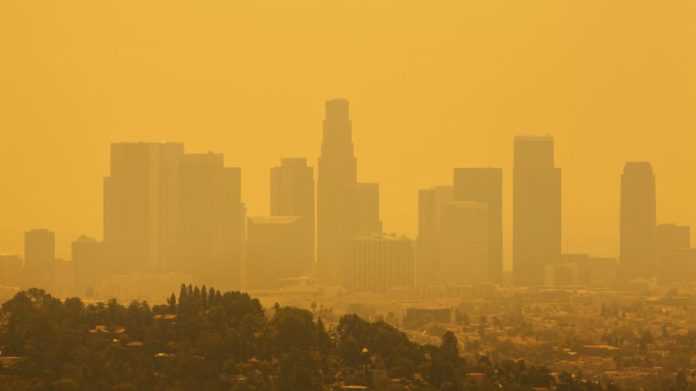It’s almost a month that Lahore is facing a serious problem of smog. Lahore being the second most polluted cities in the world is facing hazardous air which is violating the human rights to life and health.
This smog has become a more or less permanent feature throughout the province for decades now.
There are found to be various causes of this smog in Punjab such as burning rubbish, fuel exhausts, industrial emissions and dust from construction sites especially the orange train project
It is really something very serious because smog is detrimental for our health. We all should know about smog, it’s harmful effects on humans and how to deal with this hazardous air pollution .
SMOG
The word smog comes from a combination of the words smoke and fog.
Smog is technically known as ‘day darkness’, and can be classified meteorologically in degrees of severity.
It refers to human-caused air pollution that creates a hazy cloud near the ground similar to fog though, smog is formed from pollution. The most common source of smog is car emissions. It can contain many different pollutants as well. In the past, burning large amounts of coal also formed smog. Smog is the combination of different industrial gases released into the air, which makes up a kind of fog we call “smog.” It makes people cough when they breathe it. If certain fumes and fine particles are present in the smog, it can become poisonous.
Smog is not only a problem for visibility, but it can create serious health complications.
Now, dust is present in the air at all times. Dust is tiny particles of solid matter that can be carried in suspension by air. Dust may come from soil blowing, ocean spray, volcanic activity, forest fires, the exhaust from automobiles, and from industrial combustion processes. The latter is what you see pouring out of factory chimneys.
CAUSES OF SMOG
There are many causes, few are discussed below;
Road Dust:
They originate as construction debris or from excavation sites or from open patches of land. Fine dust remains suspended for long time in air and is major polluter.
Waste burning:
We have no scientific waste disposal method for solid waste.In fact, there is no proper mechanism to segregate organic and recyclable waste. All of it is dumped and then either burned or left in overflowing dumping grounds and landfills to degrade and get buried and often such sites catch fire and inflate tonnes of undesirable gases into the air.
Vehicle pollution :
It is a great pollutant. The city is crowded with vehicles including buses, taxis and autos(three-wheelers), the pollution they cause is really harmful, it remains in the air and causes the damage to the environment. Use of old and poorly maintained vehicles especially diesel vehicles contribute highly.
Stubble Burning:
Pollution levels increases in winters due to the burning of sticks & straws, crop stubble and residue, for preparing the soil for sowing Rabi crops.In winters, they are compounded with the naturally occurring winter fog to make smog. They add to the particulate matter and remain suspended in the air for weeks if winds don’t drive them away.
Reduction in green spaces:
Cutting of all trees to make way for more shopping and residential complexes . There are no big parks or open green spaces in towns left to absorb the smog . Water bodies are also missing each day .
EFFECTS OF SMOG
The smog is basically composed of sulphur oxides, nitrogen oxides, ozone, smoke and other particulates which are very harmful to the environment as well as human health.
Smog when mixed with water vapor can form a weak acid that can irritate the respiratory tracts of those inhaling the smog.It causes a lot of serious health problems in humans as well as other living organisms. Theses diseases commonly attacks children and senior citizens. Coughing and throat infection , difficulty in breathing , asthma attacks in persons who are already diagnosed by the disease.
Smog contains ozone and high levels of ozone can lead to inhibition of plant growth and devastating effect can be seen on crops and plants.
Where the ozone content of the smog rises to 30 ppm it becomes toxic to humans, plants, and animals; even higher levels cause death after two hours.
MOST AT RISK FROM SMOG:
Anyone who engages in strenuous outdoor activity, from jogging to manual labor, may suffer smog-related health effects. Physical activity causes people to breathe faster and more deeply, exposing their lungs to more ozone and other pollutants.
Four groups of people are particularly sensitive to ozone and other air pollutants in smog:
Children
Active children run the highest risks from exposure to smog, as children spend a lot of time playing outside. As a group, children are also more prone to asthma—the most common chronic disease for children—and other respiratory ailments than adults.
Adults who are active outdoors—Healthy adults of any age who exercise or work outdoors are considered at higher risk from smog.
People with respiratory diseases—People with asthma or other chronic respiratory diseases are more sensitive and vulnerable to the effects of ozone. Typically, they will experience adverse effects sooner and at lower levels of exposure than those who are less sensitive.
Some healthy people are simply more sensitive to the pollutants in smog than other people and may experience more adverse health effects from exposure.
Elderly people are often warned to stay indoors on heavy smog days. Elderly people are probably not at increased risk of adverse health effects from smog because of their age. Like any other adults, however, elderly people will be at higher risk from exposure to smog if they already suffer from respiratory diseases, are active outdoors, or are unusually susceptible to ozone.
SOLUTIONS TO REDUCE SMOG
There have to be as many solutions as many problems there are.
Remove Road dust:
Vacuum clean the roads. Also, all construction sites should follow construction norms according to which they have to cover the site so that dust do not enter into air through these sites. All naked grounds should be forested.
Waste Disposal Mechanism:
Segregation of waste at source is important. People must be educated about separating the solid waste into Organic and inorganic categories. Further, toxic waste such as batteries must be deposited at particular locations so that they don’t get mixed with other wastes. These must be collected separately. All inorganic waste must be recycled if possible. All Organic waste must be utilized to produce commercially viable Bio-fuel or should be scientifically dumped.
Reduce dependence on private Vehicles:
After introduction of Metro buses, the dependence has greatly reduced. It has to be further reduced. Make public transport including buses more user friendly.
Introduce more bus routes.
Industries:
Move those industries out of the city , which use fuel in any form to produce smoke. Give them electricity to run.
Stubble burning: Government can’t stop people forcefully. If you make a law, you’ll not have enough infrastructure to enforce it. What best that can be done is, introduce financial incentives in schemes related to production of bio-fuel/bio-electricity with the help of farm waste.
Farmers must also be educated about the use of bio-manure produced from farm waste.
Government should advise children and elderly to stay indoor, install air purifiers at work places and distribute free mask to the people.
We can Stop using air conditioning in all buildings to curb pollution in outside air.Halt construction activities for few days.
GROW TREES, It will not only save land from erosion, it’ll stop origin of dust.








